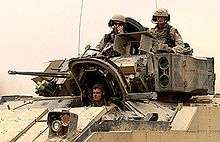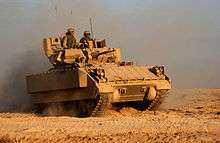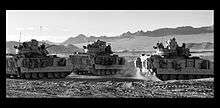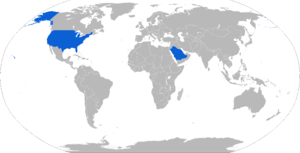M2 Bradley
| M2 Bradley | |
|---|---|
|
M2 Bradley during Operation Iraqi Freedom. | |
| Type | Infantry fighting vehicle |
| Place of origin | United States |
| Service history | |
| In service | 1981–present |
| Used by | See Operators |
| Wars | Persian Gulf War, Iraq War |
| Specifications | |
| Weight | 27.6 tonnes (30.4 short tons) |
| Length | 21.49 ft (6.55 m) |
| Width | 11.82 ft (3.6 m) |
| Height | 9.78 ft (2.98 m) |
| Crew | 3 |
| Passengers | 6 (7 in M2A2 ODS/M2A3) |
|
| |
| Armor | |
Main armament |
|
Secondary armament | 7.62 mm coaxial M240C machine gun (2,200 rounds) |
| Engine |
Cummins VTA-903T 8-cylinder diesel 600 hp (447 kW) |
| Power/weight | 19.74 hp/tonne |
| Suspension | torsion bar |
Operational range | 483 km or 300 mi |
| Speed | 56 km/h or 35 mph; 40 km/h off-road; 7.2 km/h in water |
The M2 Bradley, or Bradley IFV, is an American infantry fighting vehicle that is a member of the Bradley Fighting Vehicle family. It is manufactured by BAE Systems Land & Armaments, which was formerly United Defense.
The Bradley is designed for reconnaissance and maneuverability. The Bradley is also designed to transport a squad of infantry, providing them protection from small arms fire, while also providing firepower to both suppress and eliminate most threats to friendly infantry. The M2 can hold a crew of three: a commander, a gunner and a driver; as well as six fully equipped soldiers.
The total cost of the program is $5,664,100,000, and the average unit costs $3,166,000.[2]
Design
The Bradley IFV was developed largely in response to the amphibious Soviet BMP family of infantry fighting vehicles, and to serve as both an Armored personnel carrier (APC), and a tank-killer. One specific design requirement was that it should be as fast as the new M1 Abrams main battle tank so that they could maintain formations while moving, something which the older M113 armored personnel carrier could not do, as it had been designed to complement the older M60 Patton.
Armament
The M2's primary armament is a 25 mm cannon, which fires up to 200 rounds per minute and is accurate up to 2,500 m depending on the ammunition used. It is also armed with two BGM-71 TOW wire-guided missiles, which are held in a rectangular compartment on the left side of the turret and are capable of destroying most tanks out to a maximum range of 3750 m. However, the missiles can only be fired while the vehicle is stationary. The Bradley also carries a coaxial 7.62 mm medium machine gun, located to the right of the 25 mm chain gun.
The Bradley is equipped with the M242 25 mm autocannon as its main weapon. The M242 has a single barrel with an integrated dual-feed mechanism and remote feed selection.[3] The gun has 300 ready rounds in two ready boxes (one of 70 rounds, the other of 230 rounds), with another 600 rounds in storage. The two ready boxes allow a selectable mix of rounds, such as the M791 APDS-T (Armor-Piercing Discarding Sabot (with) Tracer), and M792 HEI-T (High Explosive Incendiary (with) Tracer) rounds. The 25 mm automatic gun is primarily used for clearing bunkers and firing on lightly armored vehicles. While the 25 mm automatic gun is not the weapon of choice for engaging tanks, vehicle commanders, crews, and CALL and Army Infantry Center personnel reported isolated instances in which the 25 mm automatic gun had killed tanks. However, Army Materiel Systems Analysis Activity (AMSAA) officials stated that, on the basis of their assessment of combat vehicles in the Persian Gulf war, for the 25 mm automatic gun to kill a tank, the tank would have to be hit at close range in its more vulnerable areas.[4] Subsequent ammunition developments resulted in the M919 APFSDS-T (Armor-Piercing Fin Stabilized Discarding Sabot with Tracer) round, which contains a finned depleted-uranium penetrator similar in concept to armor-piercing munitions used in modern tanks. The M919 was used in combat during the 2003 invasion phase of Operation Iraqi Freedom (OIF).
It is also armed with a M240C machine gun mounted coaxially to the M242, with 2,200 rounds of 7.62 mm ammunition. For engaging heavier targets (such as when acting in an anti-tank fashion), the Bradley has a TOW missile system on board, which was changed from the M2A1 model onwards to fire TOW II missiles. M2 infantry Bradleys also have turreted firing ports for a number of M231 Firing Port Weapons or FPWs, providing a button-up firing position to replace the top-side gunners on the old ACAV, though the M231 is rarely employed. Initial variants carried six, but the side ports were plated over with the new armor used on the A2 and A3 variants, leaving only the two rear-facing mounts in the loading ramp.
Countermeasures
The use of aluminum armor and the storage of large quantities of ammunition in the vehicle initially raised questions about its combat survivability. Spaced laminate belts and high hardness steel skirts have been added to later versions to improve armor protection, although this increased overall weight to 33 tons. However, actual combat operations have not shown the Bradley to be overtly deficient as losses have been few. In friendly fire incidents in Desert Storm, many crew members survived hits that resulted in total losses for lighter USMC LAV-25 vehicles.
All versions are also equipped with two four-barreled smoke grenade launchers on the front of the turret for creating defensive smoke screens, and can also be loaded with chaff and flares.
Chassis
Bradleys have a welded aluminum unit or monocoque structure to which the armor is attached, mostly on the outside. The suspension is by torsion bars and cranks. Six small rubber rimmed, divided road wheels on each side straddle the location flanges sticking up from the tread. These were originally of aluminum, but were changed to steel as vehicle weight increased. The steel treads sit on flat hard rubber tires.
Mobility
The Bradley is highly capable in cross-country open terrain, in accordance with one of the main design objectives of keeping pace with the M1 Abrams main battle tank. Whereas the M113 would float without much preparation, the Bradley was initially designed to float by deploying a flotation curtain around the vehicle. This caused some drownings due to failures during its first trials. Armor upgrades have negated this capability.
History
Production history
The M2, which was named after World War II General Omar Bradley, carries a crew of three and a six-man dismountable infantry squad.
Since entering service with the U.S. Army in 1981, 4,641 M2s have been produced.
Even after the troubled development history of the Bradley[5] additional problems occurred after production started as described in a book by Air Force Colonel James G. Burton,[6] which was adapted for the 1998 film The Pentagon Wars starring Kelsey Grammer and Cary Elwes. Burton advocated the use of comprehensive live fire tests to be used against fully loaded military vehicles to check for survivability. The Army and Navy agreed and established the Joint Live Fire testing program in 1984.[7] When testing the Bradley, however, disagreements occurred between Burton and the Ballistic Research Laboratory (BRL) at Aberdeen Proving Grounds, which preferred smaller, more controlled, "building block" tests that could be used to improve the databases used to model vehicle survivability as opposed to full up tests with random shots, which reduce the possibility of bias but produced little useful statistical data.[7] In addition, Burton insisted on a series of "overmatch" tests in which weapon systems would be fired at the Bradley that were known to be able to easily penetrate its armor. Burton saw attempts to avoid such tests as dishonest, while the BRL saw them as wasteful as they already knew the vehicle would fail.[7] The disagreements became so contentious that Congressional inquiry resulted. As a result of the tests, additional improvements to vehicle survivability were added.
Combat history

During the Persian Gulf War, M2 Bradleys destroyed more Iraqi armored vehicles than the M1 Abrams.[8] Twenty Bradleys were lost—three by enemy fire and 17 due to friendly fire incidents; another 12 were damaged. The gunner of one Bradley was killed when his vehicle was hit by Iraqi fire, possibly from an Iraqi BMP-1, during the Battle of 73 Easting.[9] To remedy some problems that were identified as contributing factors in the friendly fire incidents, infrared identification panels and other marking/identification measures were added to the Bradleys.
In the Iraq War, the Bradley proved somewhat vulnerable to improvised explosive device (IED) and rocket-propelled grenade (RPG) attacks, but casualties were light—the doctrine being to allow the crew to escape at the expense of the vehicle. As of early 2006, total combat losses included between 55 and 150 Bradleys.[10][11] By 2007, the Army had stopped using the M2 Bradley in combat, instead favoring more survivable MRAPs.[12] By the end of the war, about 150 Bradleys had been destroyed.[13]
Replacement
The U.S Army first intended to replace the Bradley as part of the Future Combat Systems Manned Ground Vehicles program, which started in 1999 and was cancelled in 2009. In 2010, the Army started the Ground Combat Vehicle program to replace the Bradley with the GCV Infantry Fighting Vehicle, but the GCV was cancelled in 2014. Informal discussions for the next follow-up effort have been dubbed as the Future Fighting Vehicle (FFV), but no official development has commenced.[14]
Variants
M2
The M2 was the basic production model, first fielded in 1981. The M2 can be identified by its standard TOW missile system, steel laminate armor, and 500 horsepower (370 kW) Cummins VT903 engine with HMPT-500 Hydro-mechanical transmission. Basic features also included an integrated sight unit for the M242 25 mm gun, and thermal imaging system. The M2 was amphibious with the use of a "swim barrier" or "flotation screen" and was transportable by C-141 Starlifter and C-5 Galaxy aircraft. All M2 vehicles have been upgraded to improved standards. The M2 armor protects the vehicle through a full 360 degrees against 14.5 mm armor-piercing incendiary (API) ammunition.
The turret was offset to the right to maximize the room in the passenger compartment. Six infantry soldiers for dismounted fighting were held in the passenger compartment. Vision for the troops was provided through three periscopes placed between the rear ramp and the cargo hatch just behind the turret, as well as two periscopes on each side of the hull above the side firing ports. The passenger compartment also held up to five TOW or Dragon missile reloads. The side and rear hull armor consisted of two 0.25 in (6.4 mm) steel plates one inch apart and 3.5 in (89 mm) away from the aluminum armor. The hull top, bottom, and front consisted of 5083 aluminum armor, and 0.357 in (9.1 mm) steel armor was added to the front third of the hull bottom to increase mine protection.[15]
M3
The M3 Bradley CFV is very similar to the M2 Bradley IFV (Infantry Fighting Vehicle) and is fielded with the same powerful two-man 25mm Bushmaster Cannon turret with the coaxial 7.62mm machine gun. It only varies from the M2 in a few subtle ways and by role. The M3 is classified as an armored reconnaissance and scout vehicle and does away with the firing ports found in the M2 series. The M3 also carries more TOW missiles as well as more ammunition for its 25mm and 7.62mm guns.
M2A1
Introduced in 1986, the A1 variant included an improved TOW II missile system, a Gas Particulate Filter Units (GPFU) NBC system, and a fire-suppression system. By 1992, the M2A1s had begun being remanufactured to upgraded standards. The GPFU system was only connected to the vehicle commander, driver, and gunner, while the infantry squad had to use their own from MOPP suits. A seventh infantryman was also added just behind the center of the turret.[15]

M2A2
Introduced in 1988, the A2 received an improved 600 horsepower (447 kW) engine with an HMPT-500-3 Hydromechanical transmission and improved armor (both passive and the ability to mount explosive reactive armor). The new armor protects the Bradley against 30 mm APDS rounds and RPGs (or similar anti-armor weapons). The new armor also eliminated the trim vane that made the Bradley amphibious and covered up the side firing ports. Spaced laminate armor was installed to the hull rear and spaced laminate track skirts protected the lower hull. A semicircular shield was attached to the turret rear to add more stowage space as well as act as spaced armor. Kevlar spall liners were added to critical areas. The troop carrying number was reduced to six, eliminating the periscope position behind the driver. After live firing testing, the seating and stowage arrangements were redrawn. These upgrades raised the cumulative gross weight of the vehicle to 30,519 kg (67,282 lb (30.037 long tons; 33.641 short tons)). The M2A2 was qualified to be transported by the C-17 Globemaster III. M2A2s were all eventually modified to M2A2 ODS or M2A3 standard.[15]
M2A2 ODS/ODS-E
The "Operation Desert Storm" and "Operation Desert Storm-Engineer" improvements were based on lessons learned during the first Gulf War in 1991. The major improvements included an eye-safe laser rangefinder (ELRF), a tactical navigation system (TACNAV) incorporating the Precision Lightweight GPS Receiver (PLGR) and the Digital Compass Systems (DCS), a missile countermeasure device designed to defeat first-generation wire-guided missiles, and the Force XXI Battle Command Brigade and Below (FBCB2) Battlefield Command Information System. The internal stowage was further improved and a thermal imaging system was added for the driver. The infantry squad was again increased to seven men, six of whom sat facing each other on two 3-man benches in the passenger compartment, with the seventh back in the position behind the turret. An MRE ('Meal, Ready-to-Eat') heater was added to the vehicle to assist in the preparation of food while in the field or warzone. With the retirement of the Dragon missile, the vehicle had the option of carrying some Javelin anti-tank missiles.[15]
M2A3

Introduced in 2000, the A3 upgrades make the Bradley IFV totally digital and upgraded or improved existing electronics systems throughout improving target acquisition and fire control, navigation, and situational awareness. Also, the survivability of the vehicle is upgraded with a series of armor improvements, again both passive and reactive, as well as improved fire-suppression systems and NBC equipment.[16]

The A3 Bradley incorporates the Improved Bradley Acquisition Subsystem (IBAS) and the Commander’s Independent Viewer (CIV). Both include a second-generation forward looking infrared (FLIR) and an electro-optical/TV imaging system, and the IBAS also has direct-view optics (DVO) and the eye-safe laser rangefinder (ELRF).[17] The CIV allows the commander to scan for targets and maintain situational awareness while remaining under armor and without interfering with the gunner’s acquisition and engagement of targets.[18]
The A3’s fire control software (FCSW) combines laser range, environmental readings, ammunition type, and turret control inputs to automatically elevate the gun for range and to automatically generate a kinematic lead solution if a target is moving.[17] This functionality, very similar to that of the M1A2 Abrams, allows the gunner or commander to center the reticule on a moving target, lase the target, and achieve a first-round-hit, without the need to fire sensing rounds and adjust aim.[18][19] The FCSW incorporates a thermal aided target tracker (ATT) function that can track two targets in the FLIR field of view and switch between them, primarily intended for employing TOW missiles against moving vehicles.[19] The FCSW also allows the turret and gunner’s sights to be slewed automatically onto a target that has been designated with the CIV.[18]
The A3 Bradley uses a position-navigation subsystem that incorporates a global positioning system (GPS), an inertial navigation unit (INU), and a vehicle motion sensor (MVS),[17] which, in addition to allowing accurate own-vehicle navigation, allows accurate position reporting and hand-off of designated targets to other units via FBCB2.[19]
The Commander’s Tactical Display (CTD) presents information from FBCB2 and the vehicle navigation systems on a moving-map display, allows the commander to communicate via text over FBCB2, and allows him to check vehicle built-in test (BIT) information and access various other information.[19] The Squad Leader’s Display (SLD) in the infantry compartment improves the situational awareness of the passengers by allowing them to view navigational information from FBCB2 and imagery from the IBAS, CIV, or Driver's Vision Enhancer (DVE) to familiarize themselves with their surroundings prior to dismounting.[17]
The M2A3 Bradley II, and an M2A3 Bradley variant used in Iraq, were included in the GCV Analysis of Alternatives.[20]
After the Iraq War, the Army began researching engineering change proposals (ECPs) for the M2 Bradley to buy back space, weight, power, and cooling capacity reduced by the addition of armor and electronics hastily added during combat. ECP1 will work to restore mobility and allow the vehicle to handle more weight. As weight increased, the Bradley got lower on its shocks, which reduced ground clearance. This decreased mobility on rough terrain and left it more vulnerable to IEDs. The effort will install lighter tracks, shock absorbers, a new suspension support system, and heavy weight torsion bars. ECP2 will restore automotive power with a larger engine, a new transmission, and a smart-power management system for better electrical power distribution to accept future networked tactical radio and battle command systems.[21][22] The first Bradleys upgraded with ECP1 were fielded in mid-2015, and the first to be upgraded with ECP2 will begin fielding in 2018.[23]
Other uses of the Bradley chassis
The Bradley series has been widely modified. Its chassis is the basis for the M270 Multiple Launch Rocket System, the M4 C2V battlefield command post, and the M6 Bradley Linebacker air defense vehicle. Armed with a quad Stinger surface-to-air missile launcher in place of the TOW anti-tank missiles, but maintaining the 25 mm autocannon, the M6 Bradley Linebacker Air Defense Vehicle (no longer in service) possessed a unique role in the U.S. Army, providing highly mobile air defense at the front line. Its suspension system has also been used on upgraded versions of the U.S. Marines' Assault Amphibious Vehicle.
Operators

Current operators
Potential operators
See also
- List of modern armored fighting vehicles
- Mechanized infantry
- M1126 Infantry Carrier Vehicle – US Army's wheeled infantry fighting vehicle
- GCV Infantry Fighting Vehicle – US Army development program for future IFV
- MICV-65 – US Army project leading to development of the M2 Bradley
- BMP Development – contemporary Soviet project
- Warrior tracked armoured vehicle – contemporary British IFV
- Armored Multi-Purpose Vehicle — Bradley APC
References
- ↑ http://www.armedforces-int.com/projects/m2_m3_bradley_fighting_vehicles.html
- ↑ "M2A3 and M3A3 Bradley Fighting Vehicle Systems (BFVS)". Federation of American Scientists.
- 1 2 Bradley M2 / M3 Tracked Armoured Fighting Vehicles, USA. Army-Technology.com. Retrieved on August 1, 2008.
- ↑ "GAO report OPERATION DESERT STORM Early Performance Assessment of Bradley and Abrams" (PDF).
- ↑ Diane L. Urbina. "Lethal beyond all expectations: The Bradley Fighting Vehicle" — in chapter 12 of George F. Hofmann and Donn A. Starry (editors) Camp Colt to Desert Storm: The History of U.S. Armored Forces, Lexington, Kentucky; The University Press of Kentucky, ISBN 0-8131-2130-2.
- ↑ James G. Burton, Col. The Pentagon Wars: Reformers Challenge the Old Guard, Annapolis, Maryland: Naval Institute Press (1993). ISBN 1-55750-081-9.
- 1 2 3 Haworth, W. Blair (1999). The Bradley and How It Got That Way: Technology, Institutions, and the Problem of Mechanized Infantry in the United States Army. Westport, Conn.: Greenwood Press. ISBN 0-313-30974-4.
- ↑ . Global Security
- ↑ Quotation from General accounting office's report about the Bradleys and Abrams performance in the Persian Gulf War: "According to information provided by the Army’s Office of the Deputy Chief of Staff for Operations and Plans, 20 Bradleys were destroyed during the Persian Gulf war. Another 12 Bradleys were damaged, but four of these were quickly repaired. Friendly fire accounted for 17 of the destroyed Bradleys and three of the damaged ones."
- ↑ L.B. Thompson, L.J. Korb, C.P. Wadhams. Army Equipment After Iraq. Lexington Institute and Center for American Progress.
- ↑ SABER RPG Report August 2008
- ↑ A Quiet Farewell For the M-2 Bradley - Strategypage.com, March 5, 2012
- ↑ The US Army’s armoured vehicle conundrum - Army-Technology.com, 11 September 2014
- ↑ US Army, Marines Struggle With Infantry Vehicle Replacements - Defensenews.com, 6 April 2014
- 1 2 3 4 M2 Variants - AFVDB.com
- ↑ NBC also stands for nuclear, biological, chemical
- 1 2 3 4 Field Manual 3-22.1, Bradley Gunnery (Nov 2003). Headquarters, Department of the Army.
- 1 2 3 Hans Halberstadt (2001). Europa Militaria No 30: Bradley Company. Ramsbury, Marlborough, Wiltshire: The Crowood Press Ltd. ISBN 1-86126-425-9.
- 1 2 3 4 Michael Green & James D. Brown (2007). M2/M3 Bradley at War. St. Paul, MN: Zenith Press. ISBN 978-0-7603-2523-0.
- ↑ "Army Evaluated Nine Vehicles Against GCV In Analysis Of Alternatives". Inside Washington Publisher. January 2010. Retrieved 12 January 2011.
- ↑ Army Develops New Concepts, Keeps Existing Fleets Rolling - Defensenews.com, 12 October 2014
- ↑ Upgrades 'new normal' for armor in uncertain budget environment - Army.mil, 20 October 2014
- ↑ Army Begins Massive Makeover of Combat Vehicle Fleet - Nationaldefensemagazine.org, 6 May 2015
Further reading
- Halberstadt, Hans (2001). Bradley Company. Europa Militaria No. 30. Wiltshire: The Crowood Press. ISBN 1-86126-425-9.
External links
| Wikimedia Commons has media related to Bradley IFV. |
- U.S. Army fact file on M2/M3 Bradley Fighting Vehicle
- M2 Bradley - Armoured Vehicles
- Bradley Fighting Vehicle Systems Upgrade to A3
